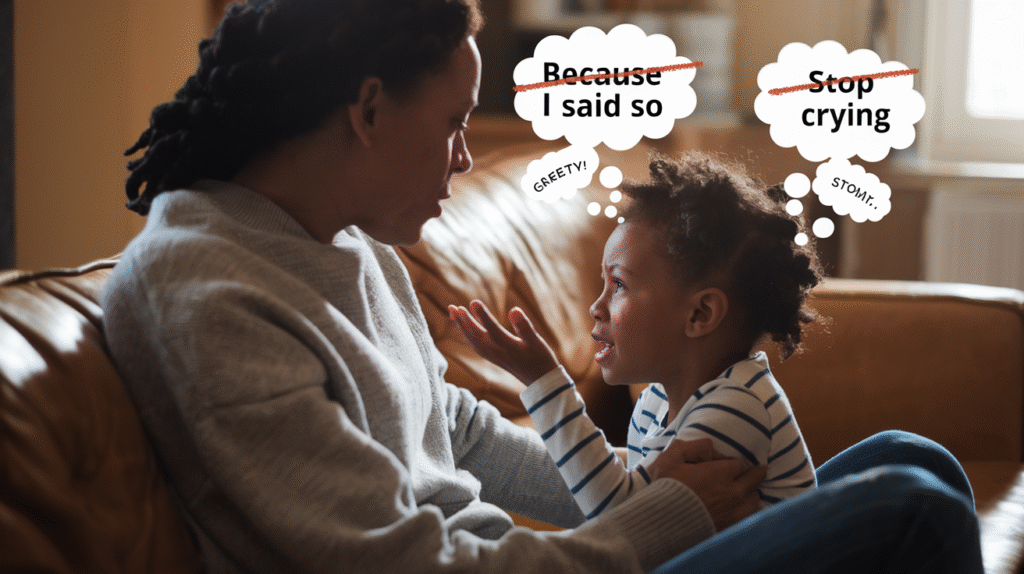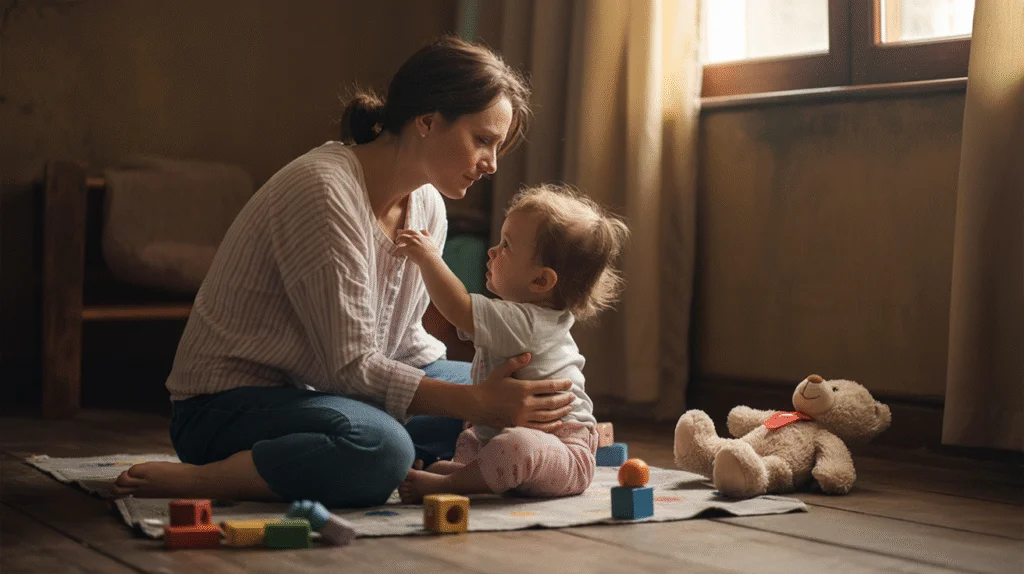
Remember the last time your kid melted down at the grocery store? While you’re busy wishing for invisibility, the parent next to you is calmly talking their screaming toddler off the ledge. What’s their secret?
Raising emotionally resilient kids isn’t about preventing feelings—it’s about teaching them to ride emotional waves without drowning. These skills don’t magically appear; they’re built through consistent, compassionate parenting.
The good news? You’re already equipped to help your child develop emotional resilience. Those everyday moments—from playground conflicts to bedtime battles—are actually golden opportunities.
But here’s what nobody tells you: the techniques that actually work aren’t what most parenting books push. The real game-changers are surprisingly counterintuitive.
Understanding Emotional Resilience in Children

What is emotional resilience and why it matters
Ever watched a kid fall, scrape their knee, cry for a minute, then bounce back to playing like nothing happened? That’s emotional resilience in action.
Emotional resilience is your child’s ability to navigate life’s ups and downs without falling apart. It’s not about avoiding feelings—it’s about experiencing them fully and still moving forward. Think of it as an emotional muscle that gets stronger with each challenge they face.
Why does this matter so much? Because life isn’t always sunshine and rainbows. Kids who can bounce back from disappointments grow into adults who don’t crumble when facing bigger problems later on.
Key components of emotional resilience
The building blocks of resilience aren’t complicated, but they’re powerful:
- Self-awareness: Kids who understand their emotions can manage them better
- Problem-solving skills: The ability to find solutions rather than dwelling on problems
- Optimism: Believing things can get better even when they’re tough
- Social connections: Strong relationships with family and friends provide support
- Coping strategies: Having healthy ways to deal with big feelings
How resilience supports mental health throughout life
Resilience isn’t just about handling childhood disappointments—it’s an investment in lifelong mental health.
Resilient kids typically show:
- Lower rates of anxiety and depression as teens and adults
- Better academic performance under pressure
- Stronger relationships
- More confidence trying new things
- Healthier responses to stress
When children learn early that they can handle difficult situations, they develop an internal strength that protects their mental health for decades to come.
Signs of emotional resilience in different age groups
Toddlers and Preschoolers (2-5 years)
- Recovers quickly from tantrums
- Attempts tasks again after failing
- Separates from parents without major distress
Elementary Age (6-10 years)
- Bounces back from friendship conflicts
- Handles disappointments without meltdowns
- Expresses feelings appropriately
Tweens and Teens (11-18 years)
- Takes responsible risks
- Learns from mistakes
- Seeks help when needed
- Maintains perspective during challenges
Remember—kids aren’t born resilient. They develop this skill through supportive relationships and experiences overcoming manageable challenges.
Building a Foundation of Security and Trust

A. Creating consistent routines and boundaries
Kids thrive when they know what to expect. A predictable daily rhythm gives them a sense of security in an often chaotic world.
Think about it – when your child knows dinner is at 6, bath time follows, then story time and bed, they can relax into that pattern. Their little brains don’t have to waste energy wondering what’s coming next.
Boundaries are just as crucial. They’re not about control but safety. Clear rules like “we don’t hit” or “screens off an hour before bedtime” actually make kids feel protected, not restricted.
The trick? Be consistent but not rigid. Sometimes ice cream before dinner won’t end the world.
B. Developing secure attachment relationships
Your relationship with your child is their emotional home base. When kids know you’ll respond to their needs, they gain the confidence to explore the world.
This doesn’t mean hovering or solving every problem. It means being emotionally available when they need you.
Simple things matter most: eye contact when they speak, putting down your phone when they enter the room, or a reassuring hug when they’re stressed.
C. Fostering a safe environment for emotional expression
Many of us grew up hearing “big boys don’t cry” or “shake it off.” That approach creates adults who bottle up feelings until they explode.
Instead, create a home where all emotions are welcome guests. When your child is upset, avoid rushing to fix or dismiss their feelings. Try “You seem really frustrated right now” instead of “You’re fine” or “Stop crying.”
Give them words for their emotions and show them healthy ways to express them. Remember, you’re not just handling today’s tantrum – you’re building tomorrow’s emotional toolkit.
Teaching Emotion Recognition and Management

A. Helping children identify and name their feelings
Kids don’t come pre-programmed to say “I’m feeling anxious” or “I’m disappointed.” They’ll scream, slam doors, or burst into tears instead. Your job? Create an emotional vocabulary.
Try this: When your child is upset, get down to their level and say, “You seem angry because your tower fell. Is that right?” This simple naming does wonders. Research shows that labeling emotions actually reduces their intensity in the brain.
Keep a feelings chart with faces showing different emotions. Point to it during calm times and heated moments. “Are you feeling more like this face or that one?”
B. Age-appropriate strategies for emotion regulation
Toddlers need different tools than tweens. Here’s what works:
For little ones (2-5):
- The turtle technique: “Pull into your shell, take three deep breaths, then come out calm”
- Sensory jars: Shake it and watch the glitter settle as you calm down
For school-age kids (6-12):
- 5-4-3-2-1 grounding: Name 5 things you see, 4 you can touch, 3 you hear, 2 you smell, 1 you taste
- Body scans: “Where do you feel that anger? Is it hot or cold?”
C. Modeling healthy emotional responses as parents
Kids aren’t listening to your lectures on emotional control. They’re watching how you handle getting cut off in traffic.
Next time you’re frustrated, narrate your process: “I’m really annoyed right now. I’m going to take some deep breaths before I respond.”
When you mess up (and you will), own it. “I didn’t handle my frustration well. Next time I’ll take a timeout before yelling.”
D. When and how to seek calm during emotional storms
Teach kids to recognize their personal “about to lose it” signals. Is it a hot face? Tight fists? Racing heart?
Create a “calm corner” with:
- Stress balls, fidgets, or stuffed animals
- Headphones with calming music
- A feelings thermometer to track intensity
The rule isn’t “go there when I send you” but “go there when you feel yourself heating up.”
E. The power of positive self-talk for children
The voice in your child’s head matters more than yours ever will.
Replace “I can’t do this!” with “This is hard, but I can try.”
Post sticky notes with phrases like:
- “Mistakes help me learn”
- “I can handle tough feelings”
- “I don’t have to be perfect”
Practice together: “When you feel scared about the test tomorrow, what can you tell yourself?” Help them build that internal cheerleader that will carry them through life’s inevitable hard times.
Developing Problem-Solving Skills

Encouraging independent thinking
Kids who think for themselves become problem-solvers for life. Start by asking open-ended questions instead of giving immediate solutions. When your child says, “I don’t know what to wear,” respond with “What do you think would be good for today’s weather?” This simple shift puts the thinking ball in their court.
Create a home environment where curiosity thrives. When your child wonders why the sky is blue, resist the urge to Google it immediately. Ask what they think first, then explore the answer together.
Teaching the steps of effective problem-solving
Problem-solving is a muscle that gets stronger with practice. Teach your kids this simple framework:
- Name the problem clearly
- Think of at least three possible solutions
- Consider what might happen with each solution
- Pick one and try it
- Reflect on how it worked
Next time your child faces a conflict with a friend, walk through these steps together. “Sam took your toy? What are three things you could do? What might happen if you tried each one?”
Allowing natural consequences as learning opportunities
When we rush to fix everything, we rob kids of valuable lessons. If your child forgets their lunch, maybe they feel hungry that day. The temporary discomfort teaches more than a lecture ever could.
The key is distinguishing between natural consequences (forgetting homework means facing the teacher) and dangerous situations where you must step in. Natural consequences build resilience precisely because they’re uncomfortable.
Nurturing Growth Mindset and Resilient Thinking

A. Praising effort over results
Kids who hear “you’re so smart” often crumble when they finally hit a challenge. Why? They start thinking their worth comes from being perfect.
Try this instead: “I love how hard you worked on that math problem!” or “The way you kept trying different strategies shows real dedication!”
When you praise effort, you’re teaching your child that their actions matter more than natural talent. They’ll learn to value the process, not just the gold star at the finish line.
B. Reframing failures as learning opportunities
The next time your child comes home upset about a mistake, resist the urge to rush in with “it’s okay.” Instead, get curious with them:
“What did you learn from that mistake?”
“What might you try differently next time?”
This isn’t about sugar-coating failures—it’s about helping kids see that setbacks aren’t dead ends. They’re detours that often lead to better understanding.
C. Encouraging perseverance through challenges
Nothing builds resilience like sticking with something tough. When your child wants to quit, acknowledge their feelings first: “I can see this is really frustrating for you.”
Then guide them toward pushing through: “What’s one small step you could take right now?” or “Remember how you felt when you mastered riding your bike after all those falls?”
D. Building confidence through incremental challenges
Think of confidence like a muscle that grows stronger with the right amount of challenge—not too easy, not impossibly hard.
Create a “challenge ladder” with your child, breaking down big goals into manageable steps. Each rung they climb builds belief in their ability to handle the next one.
When they succeed, ask: “What strengths helped you do that?” This teaches them to recognize their own capabilities rather than depending on your approval.
Strengthening Social Connections

Teaching empathy and perspective-taking
Kids who can step into someone else’s shoes are better equipped to navigate social waters. You can nurture this skill during everyday moments – when reading stories, pause and ask, “How do you think that character feels right now?” Or when conflicts arise, prompt with “How would you feel if that happened to you?”
Role-playing games work wonders too. Take turns pretending to be different people facing various situations. This hands-on practice helps children recognize emotional cues and understand different viewpoints.
Real-world opportunities are everywhere. When you see someone struggling at the playground or in a movie, talk about it. “Did you notice how that boy looked sad when no one would play with him? What could we do to help?”
Developing conflict resolution skills
Arguments between kids aren’t just headaches—they’re golden learning opportunities. Teach your children a simple framework: express feelings with “I” statements, listen to the other person, and brainstorm solutions together.
A helpful approach:
- Take a breath when emotions run high
- Use words like “I felt hurt when…” instead of “You always…”
- Really listen to the other person’s side
- Work together on fixing the problem
Practice these steps at home before kids need them in the wild. Role-play common playground scenarios so the process becomes second nature.
Building supportive peer relationships
Strong friendships act as emotional safety nets for children. Encourage your kids to develop a diverse circle of friends rather than relying on just one or two pals.
Arrange playdates with various children and observe their interactions without micromanaging. When your child mentions friend troubles, resist the urge to jump in with solutions. Instead, ask questions like “What do you think might work?” or “Have you tried talking to them about how you feel?”
Help them recognize healthy vs. unhealthy friendship patterns. Good friends make you feel good about yourself, respect boundaries, and stick around during tough times.
Practical Resilience-Building Activities for Different Ages

A. Resilience games for preschoolers
Little ones build emotional muscles through play. Try “Feelings Charades” where kids act out emotions for others to guess. This helps them recognize and name feelings early on. Another winner? “Turtle Technique” – teach kids to go into their “shell” (hug themselves, breathe deep) when overwhelmed, then come out ready to talk about feelings.
Set up simple obstacle courses in your living room. When they struggle, resist rushing to help. Instead say, “This is hard, but I know you can figure it out!” You’re teaching persistence without saying a word.
B. Emotional intelligence exercises for elementary-aged children
Elementary kids thrive with “Feelings Detective” activities. Have them spot emotions in books, shows, or family members. Ask: “How did you know they felt sad?” This builds their emotional vocabulary beyond just “good” or “bad.”
Create a “Calm Down Corner” with fidget toys, journals, and breathing prompt cards. When homework frustration hits, guide them there instead of immediately solving their problem.
Try the “Rose, Bud, Thorn” dinner game – everyone shares something good (rose), something they’re looking forward to (bud), and a challenge (thorn). Kids learn that everyone faces ups and downs daily.
C. Stress management techniques for tweens and teens
Teenagers need tools they’ll actually use. Introduce them to phone apps like Headspace (with teen-specific meditations) or Calm. Better yet, practice together so it doesn’t feel “cringe.”
Teach the 5-4-3-2-1 grounding technique for anxiety: identify 5 things they see, 4 things they can touch, 3 things they hear, 2 things they smell, and 1 thing they taste. It pulls them back into their bodies during stress spirals.
Physical outlets matter tremendously. Whether it’s shooting hoops, dancing in their room, or walking the dog – moving their bodies helps process big emotions that words sometimes can’t express.
D. Family rituals that build resilience
Family movie nights featuring characters overcoming challenges (Inside Out, Soul) create natural opportunities to discuss resilience. Ask open questions afterward: “Which character reminds you of yourself when things get tough?”
Create a “Family Wins” jar where everyone writes down small victories and challenges overcome. Reading these together on New Year’s Eve reminds kids that setbacks are temporary and progress happens in small steps.
Weekend “adventure days” where you purposely do something slightly challenging (hiking a new trail, trying an escape room) builds confidence through shared experiences. The message? “We figure things out together in this family.”
Supporting Children Through Life’s Challenges

A. Guiding children through everyday disappointments
Kids face small letdowns daily – not getting invited to a party, losing a game, or getting a poor grade. These moments are actually golden opportunities to build resilience.
When your child faces disappointment, resist the urge to fix everything. Instead, acknowledge their feelings: “I see you’re upset about not making the team. That’s really hard.” This validation helps them recognize emotions without being overwhelmed by them.
Then, guide them toward perspective: “What’s one good thing that might come from this?” Help them reframe setbacks as temporary rather than permanent disasters.
Teach the simple formula: Feel, Deal, Heal. Let them feel sad, help them deal with what happened, then move toward healing by finding new solutions.
B. Helping children navigate major life transitions
Big changes like moving homes, changing schools, or family restructuring can rock a child’s world.
The key is preparation plus ongoing support. Before a transition, talk openly about what’s coming. “We’re moving next month. What are you excited about? What worries you?”
Create continuity wherever possible. If changing schools, see if they can maintain some friendships or activities from before. During transitions, maintain routines – regular mealtimes, bedtimes, and family rituals provide security when everything else seems uncertain.
Check in regularly with simple questions: “How’s your heart feeling today about our new place?” These conversations normalize the ups and downs of adaptation.
C. Building resilience during family crises
When serious challenges hit – illness, job loss, divorce – children need extra support to maintain emotional equilibrium.
Provide age-appropriate information without overwhelming details. Kids sense when things are wrong, and their imaginations often create scenarios worse than reality. A simple explanation like, “Dad and I are having problems getting along, but we both love you completely” gives enough context without burdening them.
Maintain family strength through:
- Regular check-ins to discuss feelings
- Creating “normal” moments amid chaos
- Emphasizing that the crisis isn’t their fault
- Pointing out small improvements when they happen
Your calm presence matters more than perfect words. Children gauge their safety by watching your response.
D. When and how to seek professional support
Sometimes, children need more help than parents alone can provide. Watch for warning signs:
- Persistent changes in sleep or appetite
- Withdrawal from activities they once enjoyed
- Regression to earlier behaviors
- Expressions of hopelessness
- Extreme emotional reactions to minor triggers
Trust your instincts. If you’re concerned, start with your pediatrician who can refer you to appropriate resources like child psychologists or family therapists.
When seeking help, frame it positively: “We’re meeting with someone who helps families feel stronger together” rather than suggesting something is “wrong” with your child.
Professional support isn’t a parenting failure – it’s smart parenting that provides your child with additional tools for emotional wellness.

Raising emotionally resilient children requires intentional parenting that begins with building a foundation of security and trust. By teaching your children to recognize and manage their emotions, develop problem-solving skills, and cultivate a growth mindset, you equip them with essential tools to navigate life’s inevitable challenges. The practical resilience-building activities tailored to different developmental stages, along with nurturing strong social connections, further strengthen your child’s emotional armor.
Remember that your role as a parent isn’t to shield your children from all difficulties, but rather to support them as they learn to face and overcome obstacles. By implementing the strategies outlined in this guide, you’re not just raising happier, more adaptable children—you’re preparing them to become resilient adults who can thrive in an ever-changing world. Start today with even small steps toward emotional resilience, and watch your children grow stronger with each challenge they face.




